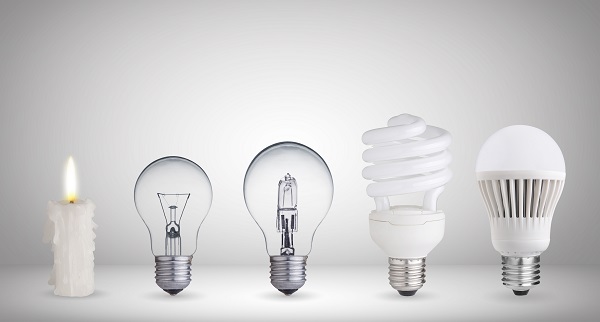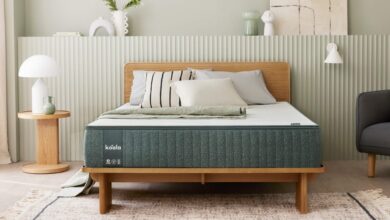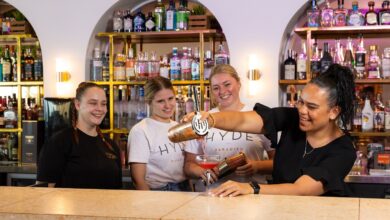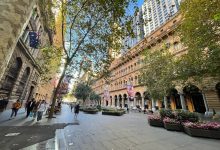
LED lighting vs. halogen
Designing a lighting fit-out or upgrade for a hotel can be an epic adventure but it’s an adventure that requires some knowledge and planning. Rose-coloured glasses will not look favourably upon a stark glare from overhead lights, or lights so dim that your guests are squinting to see their travelling companions.
Lighting matters, and it requires a degree of expertise and some understanding of how people respond to light and colour. In Quality Lighting for High Performance Buildings, author Michael Stiller wrote: “Quality lighting is the result of an integrative design process in which the building design, interior design, and lighting design evolve together to create a built environment that is sustainable, productive, and healthy for the people who occupy it.” His 2012 publication also prompts readers to acknowledge that ‘lighting is not all about the lights’.
In a journal article titled ‘Best practices in hotel architecture’, published in Cornell Hotel and Restaurant Administration Quarterly, Siguaw and Enz suggested that successful guestrooms adopt a home-like environment so guests can feel at ease. How can a hotel manager or operator have their lighting contribute positively to this? AMG took this one to the field to gather insight from some industry specialists.
Industry views
Working with light to create ambience
Louis Pavlos of EzyasLED says lighting defines the ambience of the space. “From illuminance, glare limitation and luminance distribution to light colour, colour rendering, direction of light and modelling,” Mr Pavlos suggests the implications for guest experience are far-reaching.
Lighting in hotels can be achieved through a combination of elements, not just the actual lights. Mahmoud Kebbi from Legrand Australia explained that assessment of rooms and spaces must precede recommendations.
For example, the placement of windows will affect how much light is naturally available, therefore determining the artificial light required. In the interest of guest comfort, “installing luminaires with dimming options ensures the correct light level is achieved”. It also allows for variations in natural light throughout the day, as well as mood lighting in the evening.
The degree of ‘reflectance’ from internal surfaces also contributes. “With reflectance, I am referring to the colour and finish of the walls, ceiling and carpet,” Mr Kebbi elaborated. When choosing lighting for a space, the form and function of the facility must underpin the selection process. The lighting selected for each space will form a part of the guests’ impression of the hotel; how it interacts with the intended use of the space is vital.
“In a bar or restaurant, for example; luminaires need to ensure that they not only offer the required general light and mood lighting levels, but also form part of the overall design aesthetics of the area.” Lighting can not only be functional here, but a branding strategy.
In a feature space, like a dining room, Mr Kebbi recommends using the lights to contribute to the décor. “Using pendants that appeal to guests, and suit the décor can support the branding of the hotel.”
Vancouver-based interior designer Ami McKay was quoted in an article on bchydro.com, sharing the ideal ingredients for bedroom lighting, covering relaxation, as well as task lighting which within a bedroom, covers reading, dressing and often in the case of hotel rooms; working.
“For a bedside lamp to offer enough light without producing glare when reading in bed, the lampshade should sit no higher than your shoulder-line,” Ms Mckay advised, suggesting that the ideal lampshade will be opaque with a narrow top to focus light downward for reading.
“Tiny recessed LED lights in a bedroom wash light over a wall feature such as a stone fireplace or artwork” and “directional LED lights may be placed flush to the floor to reflect upward, within the ceiling to reflect downward, or inset midway up the wall to subtly light a path to the bathroom”. Working with a designer, or reading widely on design principles can help create a memorable atmosphere, carefully customised to suit the purpose of the space.
LED lighting vs. halogen
As more hotels switch to LED, the benefits become increasingly apparent. Mr Pavlos told AMG that “halogen lights simply cannot provide the quality of directional light that LED can, and when considering quality, longevity, and energy usage”, the general shift towards LED is making a whole lot of sense.
From a purely economic perspective, the cost and energy savings are clear. Mr Pavlos estimates the longer life span at seven to ten times that of a halogen globe and indicated that (coupled with reduced maintenance) the higher initial outlay still delivers a return on investment within a few years.
“LED lights achieve instant light, with no warm up time”, and achieve a reduction in heat, as they “run at a cooler temperature”. Mr Pavlos concluded with the news that “LED lights do not contain any toxic substance like mercury”.
Mahmoud Kebbi further supported LED as a green choice when sharing his view. “With a significant reduction in energy consumption, reduction of CO2 emissions results,” he explained, citing a typical LED fixture as boasting up to A 50,000-hour life.
Mr Kebbi warned that one colour temperature setting does not fit all. “You want warmer colours for mood and ambient lighting”, such as in an intimate dining setting, or guestrooms. For recreational areas, on the other hand, Mr Kebbi recommended a cooler colour temperature. “Generally warmer colours are used in rooms and for dining, as warmer colour temperatures create a perception of comfort, relaxation, and a warm environment, while cooler colour temperatures stimulate a brightness and alertness.”
Anecdotal evidence suggests that recreational areas are generally lit at 4000K or above, which is certainly at the cool end of the spectrum. “I have not seen any recreational area lit to a 3000K colour temperature, generally they are lit with 4000K and above,” Mr Kebbi concurred.
Glare
Mahmoud Kebbi agreed that luminaires should keep glare to a minimum to ensure comfort for hotel guests, but also suggested offering dimming functions to give guests more flexibility, and control over their own comfort.
A poor level of lighting comfort may not be immediately apparent, according to Mr Kebbi, and the visual discomfort may go unnoticed until eyestrain or headaches have dulled the mood. To ensure that lighting is providing comfort, it is vital to follow the guidance of Australian/New Zealand standards for interior lighting highlighted in AS/NZS 1680.
The Standard offers a wealth of guidance on how to avoid lighting discomfort, offering detailed recommendations on factors such as the management of glare, optimum lighting levels for various applications of rooms, colour temperature suggestions, and colour rendering requirements.
Mr Kebbi paints a sublime possibility. “Offer lighting that works with temperature and blind control; at the push of a ‘comfort button’, the lights dim, window shades close, and the temperature is regulated – giving a full three-dimensional comfort experience.”
While this may not be within every operator’s reach, there are clear and transferrable concepts: comfort, ease and flexibility. Can your guest see well enough to review an important business contract at the desk provided? Can they then relax on the lounge in the absence of glare and harsh lighting? Can they dial up the type of lighting they desire?
Mr Kebbi said that “a hotel stay is all about the journey” adding that “it’s their experiences and enjoyment while they stay with you that create the memories that have guests returning and recommending”.
Both respondents agreed that when energy savings were included in the costing, LED would most probably prove more cost effective than traditional luminaires, and offered flexible options.
“The alternative range available in LED now provides something that suits the look and feel of most hotels,” added Louis Pavlos.
The word on the street is clear: lighting is a central piece in the guest-comfort puzzle. In their comprehensive 2001 title, Building Type Basics for Hospitality Facilities, McDonough et al. stated that ‘hotels are in the business of memories’. If memories are your business, have them remembered through the ‘comfort-lens’ of thoughtful and sensitive lighting design.

AccomNews is not affiliated with any government agency, body or political party. We are an independently owned, family-operated magazine.







